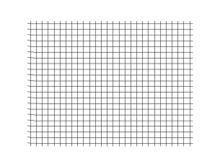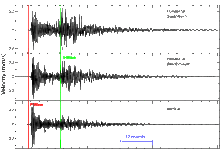Seismic wave
This is the sighted version that was marked on April 29, 2021. There are 3 pending changes that still need to be sighted.
Seismic waves, also called earthquake waves, are caused by the focal process during an earthquake and propagate from there in all directions; on their way through the earth's interior, these waves can be refracted, reflected, diffracted, scattered, absorbed and transformed.
The propagation velocities of seismic waves depend on the type of wave and the density and elasticity of the material through which the waves pass. They therefore propagate in parts of the Earth's crust, mantle, and core at different speeds, from 2 km/s to over 8 km/s.
Seismographic stations record the waves according to frequency and amplitude in seismograms; their comparison, analysis and interpretation is the subject of geophysical science, seismology or seismics. In addition to the phenomena caused naturally by earthquakes, the courses of seismic waves caused artificially by blasting or vibration are also investigated. They allow conclusions to be drawn about the structure and composition of the earth, a better understanding of the processes in the earth's interior and improved earthquake warning.
Seismic waves can also occur at other celestial bodies, for example at the surface of the sun (see helioseismology) or the surface of other stars (see asteroseismology).

Seismic waves propagate as body waves or surface waves.

Primary (P-) and secondary (S-) space waves propagate at different speeds
Seismic waves and seismic "rays"
In this article, forms of propagation (propagation) of seismic waves are described on the basis of approximate solutions, which could be called "seismic rays". The relation between "seismic rays" and "seismic waves" corresponds to that between ray optics and wave optics. A more precise description of the propagation of seismic waves is possible via partial differential equations, the so-called wave equations. These mathematical techniques correspond to those of earth spectroscopy.
Wave types
According to whether seismic waves propagate inside the earth's body or on its surface, a basic distinction can be made between body waves and surface waves. Further differences result from the type of oscillation, whether its plane is longitudinal or transverse to the direction of propagation or which form the particle movement has.
Space Waves
The designations of the primary waves (P waves) and secondary waves (S waves) described below refer to the fact that the former propagate faster: At a location distant from the quake focus, the P-waves are recorded first and only later the S-waves. From the time difference between the arrival of the P- and the S-waves, their travel time difference, the distance to the focus can be calculated. If the distance has been determined in this way at at least three different locations, the approximate position of the hypocenter can be given within the limits of measurement accuracy. The geographical location above it on the earth's surface is called the epicentre.
P-waves
P-waves, short for primary waves, are longitudinal waves, i.e. they oscillate in the direction of propagation. They can propagate in solid rocks, but also in liquids such as water or the quasi-liquid parts of the Earth's interior. They are compression waves (also: pressure or compression waves), similar to sound waves in air or water.
The propagation speed of the P-waves can be calculated with the following formula:
where K is the compressive modulus, μ 

In the Earth's crust, the speed of the P-waves is between 5 and 7 km/s, in the Earth's mantle and core it is over 8 km/s. The propagation velocity is highest in the lower mantle with almost 14 km/s, it decreases abruptly at the core-mantle boundary to about 8000 m/s (speed of sound for comparison: in air about 340 m/s, in water about 1500 m/s, in granite about 5000 m/s).
S-waves
The S-waves or secondary waves oscillate transversely to the direction of propagation (transverse wave). Since they lead to shearing of the propagation medium, they are also called shear waves. S-waves can propagate in solids, but not in liquids or gases, since the latter two have no (appreciable) shear resistance. One can therefore identify liquid areas in the earth's interior by the fact that no S-waves travel there.
The speed of propagation of the S-waves is calculated with the following formula:
With typical values of the elastic constants within the Earth, velocities of 3000 to 4000 m/s in the Earth's crust and about 4500 m/s in the upper mantle result for the S-waves. In the lower mantle the velocity increases further (see diagram of the IASP91 model in the figure). No shear waves exist in the liquid outer core of the Earth.
Surface waves
Besides the P- and S-waves as space waves, there are the surface waves. They are caused by P- or S-waves being refracted into the earth's surface. As with the S-waves, the particle movement or oscillation occurs perpendicular to the direction of propagation. However, they are distinguished by the fact that they travel along the surface and that the amplitudes of the waves decrease with depth. Moreover, the energy of the surface waves decreases with the distance r only by a factor 1/r, not like that of the space waves by a factor 1/r2 (in each case neglecting the damping). The surface waves propagate in vertical and horizontal oscillations.
Love waves
Love waves were named after the British mathematician A. E. H. Love, who in 1911 was the first to set up a mathematical model for the propagation of these waves. They are the fastest surface waves, propagating at around 2000-4400 m/s (depending mainly on the frequency and thus the depth of penetration into the Earth's crust), but slower than the S-waves. Ground motion occurs in a horizontal direction, perpendicular to the direction of propagation.
Rayleigh waves
Rayleigh waves were named after Lord Rayleigh, who mathematically proved the existence of these waves in 1885, before they were even observed. In Rayleigh waves, the ground rolls in an elliptical motion similar to ocean waves. On a homogeneous half-space, the polarization is always retrograde, i.e., the rolling motion occurs opposite to the direction of propagation of the Rayleigh wave. In the general case, prograde polarized Rayleigh waves also occur. This rolling moves the ground up and down as well as back and forth in the propagation direction of the wave. The propagation velocity is about 2000-4000 m/s, depending mainly on the wavelength. Most of the shaking felt during an earthquake is usually Rayleigh waves, whose amplitudes can become much larger than those of the other types of waves. The destructive effect of earthquakes is therefore largely due to this type of wave.
Scholte waves
Scholte waves are interface waves that propagate along the "liquid-solid" interface, for example on the sea floor. Like Rayleigh waves, they are of the P-SV type. This means that they are elliptically polarized in the radial-vertical plane. If the subsurface is stratified, the Scholte wave is dispersive, i.e., it then has frequency-dependent propagation velocities. In addition to the fundamental mode (with fundamental frequency), higher order modes (harmonics) are also formed.

P-waves (red) are recorded earlier than S-waves (green) by the seismograph (deployment times marked)

Change of propagation velocities of P- (black) and S-waves (grey) with depth in the Earth's interior according to the IASP91 reference model
Questions and Answers
Q: What are seismic waves?
A: Seismic waves are vibrating movements of the ground.
Q: What can cause seismic waves?
A: Seismic waves can be caused by underground explosions, volcanic eruptions, and man-made explosions.
Q: In which layers of the Earth do seismic waves travel?
A: Seismic waves can travel through all the layers of the Earth.
Q: What determines the speed of seismic waves?
A: The type of materials that the seismic waves meet determine their speed.
Q: What happens when seismic waves encounter different types of material?
A: When seismic waves encounter different types of material, they may bounce or go in different directions.
Q: How can we detect seismic waves?
A: Seismic waves can be detected by using seismographs.
Q: Can man-made explosions cause seismic waves?
A: Yes, man-made explosions can cause seismic waves that can vibrate the ground.
Search within the encyclopedia

